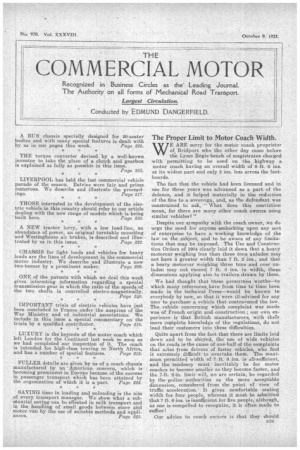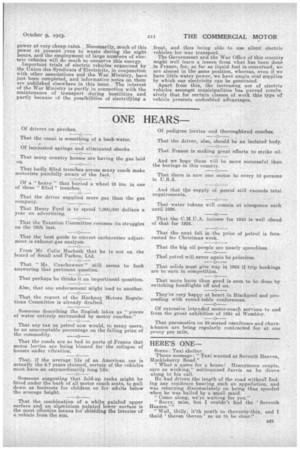The Proper Limit to Motor Coach Width.
Page 1

Page 2

Page 3

If you've noticed an error in this article please click here to report it so we can fix it.
WE ARE sorry for the motor coach proprietor of Bridport who the other day came before the Lyme Regis bench of magistrates charged with permitting to be used on. the highway a motor coach having an overall width of 8 ,ft. 6 ins. at its widest part and only 2 ins, less across the foot boards. .
The fact that the vehicle had been licensed and in use for three years was advanced as a part of the defence, and it helped materially in the redaction of the fine to a sovereign, and, as the defendant was constrained to ask, " What 'does this conviction mean, for there are many other coach owners using similar vehicles? "
Despite our sympathy with the coach owner, we do urge the need for anyone embarking upon any sort of enterprise to have a working knowledge of the law on the subject, and to be aware of any limitations that may be imposed. The Use and Construction Orders of 1904 clearly laid it down that a heavy motorcar weighing less than three tons unladen may not have a greater width than 7 ft. 2' ins., and that a heavy motorcar weighing three tons and over unladen may not exceed 7 ft. 6 ins. in width,. these dimensions applying also to trailers drawn by them.
We had thought that these prescribea widths—to which many references,have from time to time been made in the technical Press—would be known to everybody by now, so that it were ill-advised for any user to purchase a vehicle that contravened the law. The vehicle concerning which complaint was made was of French origin and construction ; our own experience is -that British manufacturers, with their more coinplete knowledge of the regulations, do not lead their customers into these difficulties.
Quite apart from the fact that there are limits laid down and to be obeyed, the use of wide vehicles on the roads is the cause of one-half of the complaints that arise from drivers of faster vehicles, who find it extremely difficultto 'overtake them. The maximum permitted width of 7, ft. 6 ins, is all-sufficient, and the tendency must• inevitably be for motor. Coaches to become smaller as they become faster, and the 2-ft. 2-in, limit will, we are certain, be regarded by the authorities as the more acceptable dimension, considered from the point of view of traffic acceleration.'. It gives comfortable seating width for four people, whereas it must be admitted that 7 ft. 6-ins. is insufficient for five people, although, as one is compelled to recognize, it is often made to siiffice!
Our advice to coach owners is that they should look into the question of the width of their coach bodies, and, during the coming period for overhaul, rectify any mistakes that may have been made.
Solid Tyre Load-carrying Capacity.
THERE IS still a great lack of uniformity between the weight-carrying capacities of different makes of solid tyres as quoted by their makers, and it is most unsatisfactory for a user to find that his vehicle, which is, apparently, correctly equipped when fitted with tyres of a certain section recommended by one manufacturer, is incorrectly so if the same section tyres of a different make be utilized. In certain instances this invidiousness 'may even affect the guarantee, where such be issued ; in any case' if it be claimed that the second set of tyres be too small for the rated load capacity of the vehicle, any failure an their part is hardly likely to appeal to the sympathy of the tyre makers. • In view of these points it is interesting to note that the Solid Rubber Tyre Committee, of the Society of Motor Manufactuters and Traders proposes to publish, as S.M.M. and T. provisional standards. a uniform load schedule for solid tyres,which, if adopted by the tyre maker, will do away with the present inconsistencies. ,
A Development in the Electrically Propelled Vehicle. A Development in the Electrically Propelled Vehicle.
AT _A: TIME when chassis designers mightsoonceivably be forgiven for resting for a while on their oars, and for thinking that a definite period had been put to the evolution of the motor vehicle, and that any new departure would be a radical one, leaving present conceptions to stand as types ; at such-a, time, when even the inventor might have been expected to be taking a well-merited rest, there is, on the contrary, such activity as has hardly been before experienced in the history of our induatry. Invention is rife. Those who would improve on present constructions, in minor or major detail, vie with those who aim at epoch-making strides, and the Patent Office knows no rest. 'Above all others, the transmission portion of the chassis is attracting attention. There are many attempts each week to solve the seemingly insoluble problem of how to replace the current type of mechanical change-speed gear by something which, while being no less efficient, shall be easier to manipulate, and shall be capable of providing an almost infinite number of ratios of gear reduction. All forms of transmission are proposed, from the simple friction drive, which still has many followers, to the highly complicated electrical type. There is one aspect of this matter, however, which will no doubt have occurred to many of the more thoughtful of our readers, and that is the influence of the electric unit, which, almost universal on touring cars, must eventually be adopted to a similar extent on heavier chassis. There is a growing tendency, on touring car chassis, to apply the current available from the starting and lighting set to other purposes. Its employment for brake operation, for example, as exemplified in a recent patent taken out
L
by Mr. anchester, is one and one which will have an exeeptional appeal, since it relieves the designer of many of the problems inseparable from the application of brakes to the front wheels of a car. The inflation of the tyres, operation of the clutch and change-speed gear, are all operations which can be performed electrically, and, as the application of the current to these purposes becomes more general, the provision of larger batteries and bigger motors and dynamos will be necessary, until the step which is. already forecasted by the principal subject on our patents page this week becomes obvious ; there will be such ample current supplies available that it will
become a matter of course to use it directly as a transmission medium.
The patent to which we have referred is ostensibly an infinitely variable gear of the electro-magnetic type. In effect, the chassis to which it is applied will become, in part, a battery-propelled chassis and, in part, a petrol-electric chassis, being a sort of halfway house between those two main types, embodying, we should think, the best features of both. It will afford the ailent transmission of the petrol-electric, with its facility for changing gear and its multitude of available ratios; it will embody a smaller engine, owing to the fact that the batteries will be able to store the power which is surplus and redeliver it when extra load demands it. On the other hand, it will not have the disadvantage of limited mileage per charge, which is inseparable from the purely batterypropelled chassis, as its charging apparatus will be carried on the chassis itself and be always at work. Altogether, this invention and, still more, the changes it suggests are well worthy of careful study.
Isolating the Drivers of Passenger Vehicles.
SINUE we last wrote on the subject of isolating the driver from the passengers in a passenger vehicle, there has certainly been a more general adoption of the idea, and, therefore, a considerable improvement in this respect. In the majority of buses the driver is now so screened off that communication by speech between interior, and exterior is rendered, difficult, if not impossible. Only a few days ago the drivers of a certain provincial bus company had to be warned against permitting members of the Public to sit beside them. We are not surprised that such a procedure could not be tolerated, and we can imagine how rapidly the us accident figures for the bigger cities would rise if the driver's attention were distracted in a similar manner, particularly if the neighbouring seats were occupied by members of the fair sex, as usually happened in the case just mentioned. The faster a vehicle travels the more important it is that all the attention of the driver should he concentrated on controlling it and keeping a constant lookout for approaching and overtaking vehicles. Few buses travel at the same speed as coaches, and it is, therefore' even more important that the coach drivers be e guarded from extraneous interference, even if this only takes the form of talking and questioning. . It is a rather more 'difficult matter to. arrange to separate the driver of an ordinary open coach from the passengers, but much can be done by fixing a screen at the back _of his seat and extending this-by means of a side screen, so that he is partially enclosed. It may seem somewhat unkind thus to segregate a human being from his fellows, but it must be remembered that he has many lives in his charge, and cannot afford to take risks.
Encouraging the Electric Vehicle Movement.
FOR MANY years France has been endeavouring to make her transport vehicles independent of foreign liquid fuel, supplies of which may quite possibly, in case of war, be cut off, or very seriously curtailed. With this purpose in view, the Govern ment ment has encouraged various societies, inventors and manufacturers to experiment with appliances which will enable home-produced fuel to be employed for the petrol motor. This is instanced by the trials of suction-gas producers, in which, incidentally, a British device gave a very creditable performance. Attention at the moment, however, is being directed to the possibility of greatly extending the employment of battery-electric vehicles, for, in respect of supplies of electricity, France is very fortunate. There are wonderful resources of water power which are rapidly being exploited, giving ample electric
power at very cheap rates. _,Necessarily, much of this power at present runs to waste during the night hours, and the employment of large numbers of eketric vehicles will do much to conserve this energy. Important trials of electric vehicles organized by the Union des Syndicats d'Electricite, in conjunction with other associations and the War Ministry, havo just been completed, and informative notes on them are published elsewhere in this issue. The interest of the War Ministry is partly in connection with the maintenance of transport during hostilities and partly because of the possibilities of electrifying a front, and thus being able to use vehicles for war transport. silent electric • -• The Government and the War Office of this country might well learn a lesson from what has been done in France, for, so far as liquid fuel is concerned, we are almost in the same position, whereas, even if we have little water power, we have ample coal supplies by which our electricity can be generated. Apart from this, the increasing use of electric vehicles amongst municipalities has proved conclusively that for certain classes of work this type of vehicle presents undoubted advantages.
































